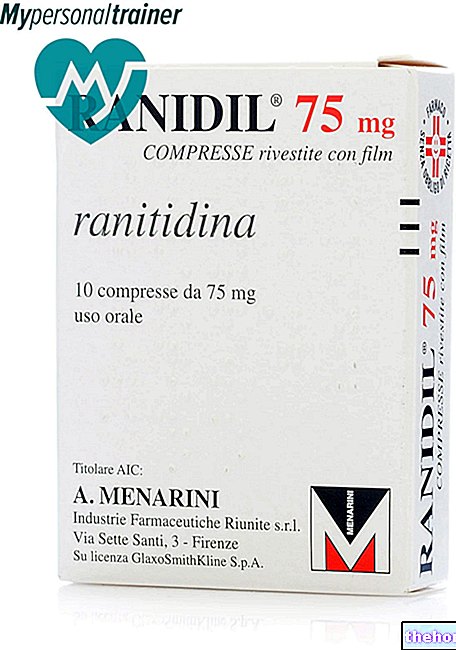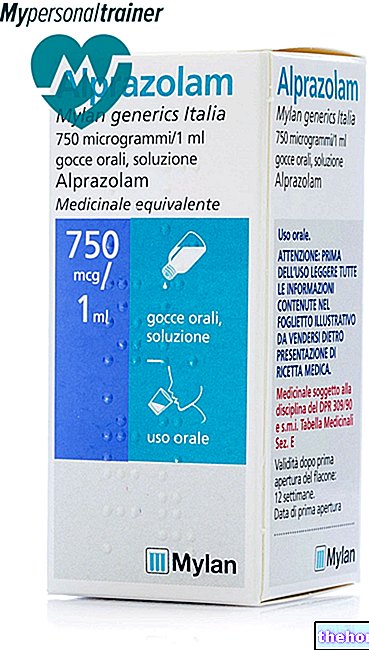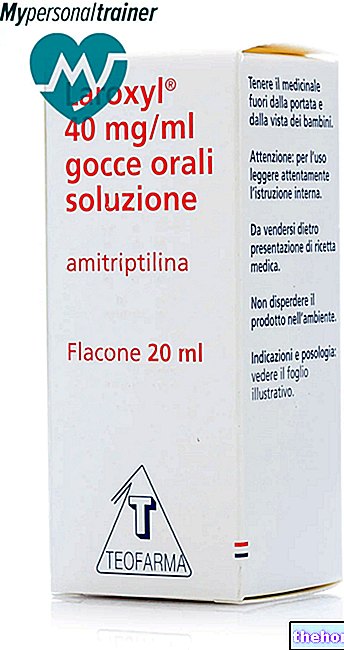Active ingredients: Tamsulosin (Tamsulosin hydrochloride)
TAMSULOSIN DOC Generici 0.4 mg modified-release hard capsules
Why is Tamsulosin used? What is it for?
The active substance in TAMSULOSIN DOC Generici is tamsulosin.Tamsulosin is a drug with a selective action antagonist of α1A / α1D adrenoceptors which reduces muscle contraction in the prostate and urethra; this facilitates the flow of urine through the urethra and facilitates urination (expulsion of urine - urinating ). In addition, it decreases the feeling of urgency to urinate.
TAMSULOSIN DOC Generici is used in men to treat symptoms of the lower urinary tract associated with Benign Prostatic Hyperplasia (BPH, or enlarged prostate). These disorders may include difficulty urinating (decreased flow), dribbling, urgency, and the need to urinate frequently both day and night.
Contraindications When Tamsulosin should not be used
Do not use TAMSULOSIN DOC Generici:
- if you are allergic to tamsulosin hydrochloride or any of the other ingredients of this medicine (listed in section 6). Hypersensitivity or allergy to tamsulosin hydrochloride may manifest as sudden local swelling of the soft tissues of the body (eg throat or tongue) and of the hands or feet, difficulty in breathing and / or itching and skin rashes (angioedema).
- if you faint from a drop in blood pressure when changing positions (sitting down or standing up).
- if you have severe liver problems.
Precautions for use What you need to know before taking Tamsulosin
Talk to your doctor or pharmacist before using TAMSULOSIN DOC Generici.
- Periodic medical check-ups are needed to monitor the development of the condition for which you are being treated.
- Fainting may occur rarely with the use of TAMSULOSIN DOC Generici, as well as with other medicines of this type. At the first signs of dizziness or weakness you should sit or lie down until they disappear.
- If you have severe kidney problems, please tell your doctor.
- if while using tamsulosin you have experienced sudden local swelling of the soft tissues of the body (eg throat or tongue) and of the hands and / or feet, difficulty in breathing and / or itching and rash, the cause of which is a reaction allergic (angioedema), tell your doctor.
- if you are undergoing or scheduled for eye surgery for clouding of the lens (cataract) or increased pressure in the eye (glaucoma), please tell your eye doctor if you have previously taken, are taking or are planning to take TAMSULOSIN DOC Generici because an "eye condition called" intraoperative flag iris syndrome (IFIS) may arise. The specialist may therefore take the most appropriate precautions regarding the pharmacological treatments and surgical technique to be used. Ask your doctor. if you have to postpone or temporarily stop taking this medicine before undergoing eye surgery due to clouding of the lens (cataract) or increased pressure in the eye (glaucoma).
Consult your doctor if you find yourself or have been in any of the above situations in the past.
Children
Do not give this medicine to children and adolescents under 18 years because the medicine is not effective in this population.
Interactions Which drugs or foods may change the effect of Tamsulosin
Other medicines and TAMSULOSIN DOC Generici
Tell your doctor or pharmacist if you are using, have recently used or might use any other medicines. Taking TAMSULOSIN DOC Generici 0.4 mg with other medicines of the same class (α1-adrenoceptor antagonists) may cause an unwanted drop in blood pressure. Diclofenac (an anti-inflammatory medicine used to combat pain of various kinds) and warfarin (used to prevent blood clotting) can affect the rate at which TAMSULOSIN DOC Generici is removed from the body.
It is especially important to tell your doctor if you are taking other medicines at the same time that may decrease the removal of TAMSULOSIN from the body (for example, ketoconazole, erythromycin).
Keep in mind that the above may also be valid for products used in a more or less recent past or to be used in a more or less near future.
TAMSULOSIN DOC Generici with food and drink
Taking TAMSULOSIN DOC Generici should take place after breakfast or after the first meal of the day, while taking it on an empty stomach may lead to an increase in side effects or the severity of any of these.
Warnings It is important to know that:
Pregnancy, breastfeeding and fertility
Tamsulosin is not indicated for women.
Abnormal ejaculation (ejaculation disorders) has been reported in the man. This means that seminal fluid does not leave the body via the urethra but enters the bladder (retrograde ejaculation) or that the ejaculation volume is reduced or absent (ejaculation failure). This event is harmless.
Driving and using machines
To date, there has been no evidence that tamsulosin alters the ability to drive or use machines.
However, you should be aware that dizziness can occur; in that case he should not undertake those activities that require attention.
Dose, Method and Time of Administration How to use Tamsulosin: Posology
Always take this medicine exactly as your doctor has told you. If you are unsure, consult your doctor or pharmacist.
The medicine is for oral use.
The recommended dose is one capsule a day after breakfast or after the first meal of the day. The capsule should be taken while standing or sitting (not lying down) and should be swallowed whole with a glass of water.
The capsule should not be crushed or chewed as this interferes with the modified release of the active ingredient.
TAMSULOSIN DOC Generici is usually prescribed for long periods of time. Effects on bladder and urination are maintained following long-term treatment with tamsulosin.
Your doctor has prescribed a dose that is suitable for you and the disease you are suffering from, specifying the duration of treatment. Do not change this dose on your own.
If you have the impression that the effect of tamsulosin is too strong or too weak, talk to your doctor or pharmacist.
Overdose What to do if you have taken too much Tamsulosin
If you take more TAMSULOSIN DOC Generici than you should
If you take more TAMSULOSIN DOC Generici than you should, contact your doctor or pharmacist immediately.
Taking an excessive dose of tamsulosin can induce an unwanted drop in blood pressure and an increase in heart rate, associated with a feeling of weakness. You may then experience dizziness, weakness, vomiting, diarrhea and fainting. effects of lowering blood pressure.
If you forget to take Tamsulosin tablets
If you have forgotten to take a dose of Tamsulosin after breakfast or after your first meal of the day, you can do so when you notice after you have eaten food. If you have missed a day, simply continue taking the daily dose as it was prescribed for you. Do not take a double dose to make up for a forgotten dose.
If you stop taking TAMSULOSIN DOC Generici
When treatment with TAMSULOSIN DOC Generici is stopped prematurely, the initial symptoms may return. Therefore, continue taking TAMSULOSIN DOC Generici for as long as your doctor prescribes, even if your symptoms have already disappeared. Always consult your doctor if you believe this therapy should be discontinued.
If you have any further questions on the use of this medicine, ask your doctor or pharmacist.
Side Effects What are the side effects of Tamsulosin
Like all medicines, this medicine can cause side effects, although not everybody gets them.
Side effects divided according to the likelihood with which they can occur:
Common effects (affects more than 1 in 100 but less than 1 in 10 patients): dizziness (particularly when sitting or standing up). Abnormal ejaculation (ejaculation disorder). This symptom means that seminal fluid does not go outside the body through the urethra but enters the urinary bladder (retrograde ejaculation) or that the volume of seminal fluid is reduced or absent (ejaculation failure. ) This event is harmless.
Uncommon effects (affects more than 1 in 1000, but less than 1 in 100 patients): headache, palpitations (feeling the heart beat faster than normal), irregular decrease in blood pressure such as standing up quickly while sitting or lying down often associated with dizziness, stuffy or runny nose (rhinitis), constipation, diarrhea, nausea, vomiting, redness of the skin (rash), itching, redness of the skin (hives), feeling of weakness (asthenia).
Rare effects (affects more than 1 in 10,000 but less than 1 in 1,000 patients): feeling faint (fainting); sudden localized swelling of the soft tissues of the body (e.g. throat and tongue) and of the hands and / or feet, difficulty breathing with or without itching and redness of the skin (rash), as frequently in an allergic reaction (angioedema).
Very rare effects (affects less than 1 in 10,000 patients): severe rash, inflammation, blistering of the skin and / or mucous membranes of the lips, eyes, mouth, nostrils or genitals (Stevens-Johnson syndrome); involuntary, prolonged and painful erection that requires immediate medical treatment (priapism).
Effects with frequency not known (frequency cannot be estimated from the available data): blurred vision, visual impairment, nosebleed (epistaxis), severe skin rash (erythema multiforme, exfoliative dermatitis), dry mouth, abnormal irregular heart rhythm (atrial fibrillation, arrhythmia, tachycardia), difficulty in breathing (dyspnoea). If you are about to have eye surgery due to clouding of the lens (cataracts) or increased pressure in the eye (glaucoma) and if you are already taking or have recently taken TAMSULOSIN DOC Generici, the pupil may dilate poorly and the iris (the colored circular part of the eye) can become flaccid during surgery.
Reporting of side effects
If you get any side effects, talk to your doctor or pharmacist. This includes any possible side effects not listed in this leaflet. You can also report side effects directly via the national reporting system at https://www.aifa.gov.it/content/segnalazioni-reazioni-avverse.
By reporting side effects you can help provide more information on the safety of this medicine.
Expiry and Retention
Keep this medicine out of the sight and reach of children.
- Blisters: Store in the original package.
- Tablet container: keep the bottle tightly closed.
Do not use this medicine after the expiry date which is stated on the blister or bottle and carton after "EXP". The expiry date refers to the last day of that month.
Do not throw any medicines via wastewater or household waste. Ask your pharmacist how to throw away medicines you no longer use. This will help protect the environment.
Composition and pharmaceutical form
What TAMSULOSIN DOC Generici contains
The active ingredient is 0.4 mg tamsulosin hydrochloride.
The other ingredients are:
Capsule contents: microcrystalline cellulose, methacrylic acid - ethyl acrylate copolymer (1: 1), polysorbate 80, sodium sulfate, triethyl citrate, talc.
Capsule body: gelatin, indigo carmine (E132), titanium dioxide (E171), yellow iron oxide (E172), red iron oxide (E172), black iron oxide (E172).
Ink: shellac, black iron oxide (E172), propylene glycol.
What TAMSULOSIN DOC Generici looks like and contents of the pack
TAMSULOSIN DOC Generici capsules are orange / olive green with a black stripe on both ends and black "TSL 0.4" on the capsule.
The pack sizes available are blisters or tablet containers of 10, 14, 20, 28, 30, 50, 56, 60, 90, 100 or 200 capsules.
Not all pack sizes may be marketed.
Source Package Leaflet: AIFA (Italian Medicines Agency). Content published in January 2016. The information present may not be up-to-date.
To have access to the most up-to-date version, it is advisable to access the AIFA (Italian Medicines Agency) website. Disclaimer and useful information.
01.0 NAME OF THE MEDICINAL PRODUCT
TAMSULOSIN DOC GENERICI 0.4 MG HARD MODIFIED RELEASE CAPSULES
02.0 QUALITATIVE AND QUANTITATIVE COMPOSITION
One capsule contains 0.4 mg of tamsulosin hydrochloride.
For the full list of excipients, see section 6.1.
03.0 PHARMACEUTICAL FORM
Modified-release capsules, hard.
Orange / olive green capsules, imprinted with the black TSL 0.4 mark and with a black line on both ends. The capsules contain white to off-white granules.
04.0 CLINICAL INFORMATION
04.1 Therapeutic indications
Treatment of lower urinary tract symptoms (LUTS) associated with benign prostatic hyperplasia (BPH).
04.2 Posology and method of administration
Oral use.
One capsule per day to be taken after breakfast or after the first meal of the day.
The capsule must be swallowed whole and must not be crushed or chewed, as this could interfere with the modified release of the active ingredient.
No dose adjustment is required in renal impairment or in patients with mild to moderate hepatic impairment (see section 4.3 "Contraindications").
Pediatric population
The safety and efficacy of tamsulosin in children under the age of 18 has not yet been established.
Currently available data are reported in section 5.1.
04.3 Contraindications
Hypersensitivity to tamsulosin hydrochloride, including drug induced angioedema, or to any of the excipients.
History of orthostatic hypotension.
Severe hepatic insufficiency.
04.4 Special warnings and appropriate precautions for use
As with other α1-adrenoceptor antagonists, a reduction in blood pressure may occur in some patients with treatment with TAMSULOSIN and rarely can result in syncope. At the first signs of orthostatic hypotension (dizziness, weakness), the patient should sit or lie down until the symptoms disappear.
Before initiating therapy with TAMSULOSIN DOC Generici, the patient should be checked for other conditions that may cause symptoms similar to those of benign prostatic hyperplasia. Before treatment, and at regular intervals thereafter, they should rectal examination and, if necessary, determination of prostate specific antigen (PSA) be performed.
The treatment of patients with severe renal insufficiency (creatinine clearance less than 10 ml / min) should be considered with caution, as these subjects have not been studied.
Angioedema has rarely been reported following the use of tamsulosin. In this case, treatment should be discontinued immediately, the patient monitored until the edema subsides and tamsulosin should not be re-administered.
Intraoperative Floppy Iris Syndrome (IFIS, a variant of the pupil syndrome) has been observed during cataract surgery in some patients on or previously treated with tamsulosin hydrochloride. small).
IFIS may increase the risk of ocular complications during surgery.
It is not recommended to initiate tamsulosin therapy in patients scheduled for cataract surgery.
Discontinuation of tamsulosin treatment 1-2 weeks prior to cataract surgery is anecdotally considered useful, however the benefit and duration of discontinuing therapy prior to surgery has not yet been established.IFIS has also been found in patients who had stopped tamsulosin hydrochloride for a longer period prior to cataract surgery.
During the pre-operative evaluation, the ophthalmologist and surgical team should consider whether patients awaiting cataract surgery are being treated or have been treated with tamsulosin to ensure that appropriate measures can be taken to manage the "IFIS during the" intervention.
Tamsulosin hydrochloride should not be prescribed in combination with strong inhibitors of CYP3A4 in patients with poor metabolising CYP2D6 phenotype.
Tamsulosin hydrochloride should be used with caution in combination with strong and moderate inhibitors of cytochrome CYP3A4 (see section 4.5).
04.5 Interactions with other medicinal products and other forms of interaction
Interaction studies were performed in adults only.
No interaction was observed when tamsulosin hydrochloride was combined with atenolol, enalapril or theophylline.
The plasma concentration of tamsulosin is increased by the concomitant intake of cimetidine and is reduced by that of furosemide. However, as the concentration of tamsulosin remains within the therapeutic range, the dosage does not need to be changed.
In in vitro studies, the free fraction of plasma tamsulosin was not modified by diazepam, propranolol, trichlormethiazide, chlormadinone, amitriptyline, diclofenac, glibenclamide, simvastatin and warfarin. Tamsulosin does not modify the free fraction of diazepam, propranolol, trichlorometiazide and chlormadinone. However, diclofenac and warfarin can increase the rate of elimination of tamsulosin.
In in vitro studies with hepatic microsomal fractions (representative of the drug metabolizing enzyme system linked to cytochrome P450) with amitriptyline, salbutamol, glibenclamide and finasteride there was no evidence of interactions at the level of hepatic metabolism.
Concomitant administration of tamsulosin hydrochloride with potent CYP3A4 inhibitors may lead to increased exposure to tamsulosin hydrochloride. Concomitant administration with ketoconazole (a known potent inhibitor of CYP3A4) resulted in an increase in AUC and Cmax of tamsulosin hydrochloride by a factor of 2.8 and 2.2 respectively.
Tamsulosin hydrochloride should not be administered in combination with potent CYP3A4 inhibitors in patients with poor metabolising CYP2D6 phenotype.
Concomitant administration of tamsulosin hydrochloride with paroxetine, a potent inhibitor of CYP2D6, resulted in an increase in Cmax and AUC of tamsulosin by a factor of 1.3 and 1.6 respectively, but these increases are not considered clinically relevant.
Co-administration of other α1-adrenoceptor antagonists may lead to hypotensive effects.
04.6 Pregnancy and lactation
Tamsulosin is for use by male patients only.
04.7 Effects on ability to drive and use machines
No studies on the effects of tamsulosin on the ability to drive or use machines have been performed. However, patients should be advised of the possibility of tamsulosin causing dizziness.
04.8 Undesirable effects
A variant of the small pupil syndrome known as "Intra-operative Floppy Iris Syndrome" (IFIS) associated with tamsulosin therapy has been observed during cataract surgery during postmarketing surveillance (see also section 4.4).
Post-marketing experience: In addition to the adverse events listed above, atrial fibrillation, arrhythmia, tachycardia and dyspnoea have been reported in association with the use of tamsulosin. As these are events reported spontaneously during post-marketing experience, the frequency of events and the role of tamsulosin cannot be established with certainty.
04.9 Overdose
One case of acute overdose with tamsulosin 5 mg has been reported. Acute hypotension (systolic blood pressure of 70 mm Hg), vomiting and diarrhea were observed, which were treated by fluid replacement; the patient was discharged the same day.
In the event of acute hypotension following overdose, cardiovascular support should be provided. Blood pressure and heart rate can be restored to normal by having the patient lie down. If this is not enough, it will be possible to use volume expanders and, where necessary, vasopressors. Renal function should be monitored and general supportive measures applied.
Dialysis is of little use as tamsulosin binds strongly to plasma proteins.
Certain measures, such as inducing vomiting, can be taken to prevent absorption. In case of ingestion of large quantities of the drug, it may be necessary to perform a gastric lavage and simultaneously administer activated charcoal and an osmotic laxative, such as sodium sulphate.
05.0 PHARMACOLOGICAL PROPERTIES
05.1 Pharmacodynamic properties
Pharmacotherapeutic group: alpha1 adrenoceptor antagonist.
ATC code: G04C A02. Preparations for the exclusive treatment of prostate disorders.
Mechanism of action
Tamsulosin selectively and competitively binds with post-synaptic α1A adrenoceptors which induce smooth muscle contraction to relax smooth muscle in the prostate and urethra.
Pharmacodynamic effects
Tamsulosin increases the maximum rate of urinary flow by relaxing the smooth muscles of the prostate and urethra, eliminating the obstruction. In addition, the product improves symptoms of irritation and obstruction in which the contraction of the smooth muscle of the lower urinary tract plays an important role.
Alpha1-blockers can reduce blood pressure by lowering peripheral resistance.
No clinically relevant reduction in blood pressure was observed in studies with tamsulosin in normotensive patients.
The effects of the drug on the symptoms of filling and emptying the bladder are maintained even during long-term therapy and, consequently, the need to operate is postponed over time.
Pediatric population
A double-blind, randomized, placebo-controlled, dose-escalating study was performed in children with neurogenic bladder. A total of 161 children (aged 2-16 years) were randomized and treated with 1 of 3 tamsulosin dose levels (low [0.001-0.002 mg / kg], medium [0.002-0.004 mg / kg], and high [0.004-0.008 mg / kg]) or with placebo. The primary endpoint was the number of patients who had a decrease in their detrusor leakage pressure point (LPP) due to stabilization of hydronephrosis and hydroureter and modification of urine volume obtained by catheterization and number of urine leaks during catheterization as reported. in catheterization diaries.No statistically significant differences were found between the placebo group and any of the 3 tamsulosin dose groups for the primary and secondary endpoints.No dose-response relationship was observed for each dose level.
05.2 "Pharmacokinetic properties
Absorption
Tamsulosin is rapidly absorbed from the intestine and its bioavailability is almost total. Absorption is slowed down when taken close to meals. Uniformity of absorption is ensured by always taking tamsulosin after the usual breakfast.
Tamsulosin exhibits linear kinetics.
Peak plasma concentrations are reached approximately six hours after a single intake of tamsulosin, after a full meal. Steady state is reached on the fifth day of treatment, when Cmax in patients is approximately two-thirds higher than that seen after a single dose.
Although this has only been demonstrated in the case of elderly patients, the same result is also expected in the case of younger patients.
Regarding the plasma concentrations of tamsulosin, there are significant differences between patients, both after a single dose and after repeated doses.
Distribution
In men, tamsulosin is more than 99% bound to plasma proteins with a limited volume of distribution (approximately 0.2 l / kg).
Biotransformation
Tamsulosin has a poor first pass effect as it is metabolized slowly. Most of the tamsulosin is found in the plasma unchanged. The substance is metabolized in the liver.
In studies in rats, tamsulosin was found to cause only mild induction of hepatic microsomal enzymes.
The metabolites do not have the same efficacy and toxicity as the active drug.
Excretion
Tamsulosin and its metabolites are eliminated mainly through the urine in which approximately 9% of the dose is present in unchanged form.
The elimination half-life of tamsulosin is approximately 10 hours (when taken after a meal) and 13 hours at steady state.
05.3 Preclinical safety data
Toxicity after a single dose and after repeated doses was studied in mice, rats and dogs. Reproductive toxicity was studied in rats, carcinogenicity in mice and rats. Genotoxicity was investigated in vivo And in vitro.
The common toxicity profile seen with high doses of tamsulosin was equivalent to the pharmacological effect associated with alpha-adrenergic antagonists.
In dogs, at extremely high dosages, alterations in ECG reading were observed, although of no clinical relevance. Tamsulosin has not been shown to have significant genotoxic properties.
Upon exposure to tamsulosin, major proliferative changes were detected in the mammary glands of female rats and mice. These changes, probably indirectly linked to hyperprolactinaemia and occurring only following the intake of high doses, are of no clinical significance.
06.0 PHARMACEUTICAL INFORMATION
06.1 Excipients
Capsule contents
Microcrystalline cellulose
Methacrylic acid - ethyl acrylate copolymer (1: 1)
Polysorbate 80
Sodium lauryl sulfate
Triethyl citrate
Talc.
Capsule body
Jelly
Indigo carmine (E132)
Titanium dioxide (E171)
Yellow iron oxide (E172)
Red iron oxide (E172)
Black iron oxide (E172).
Ink
Shellac
Black iron oxide (E172)
Propylene glycol.
06.2 Incompatibility
Not relevant.
06.3 Period of validity
3 years.
06.4 Special precautions for storage
Blisters: Store in the original package.
Tablet container: keep the container tightly closed.
06.5 Nature of the immediate packaging and contents of the package
Cardboard cartons containing 10, 14, 20, 28, 30, 50, 56, 60, 90, 100 and 200 modified release capsules in PVC / PE / PVDC / aluminum blisters.
HDPE bottles with PP security closure containing 10, 14, 20, 28, 30, 50, 56, 60, 90, 100 and 200 modified release capsules.
Not all pack sizes may be marketed.
06.6 Instructions for use and handling
No special instructions.
07.0 MARKETING AUTHORIZATION HOLDER
DOC Generici S.r.l. - Via Turati 40 - 20121 Milan - Italy.
08.0 MARKETING AUTHORIZATION NUMBER
Modified-release capsules, 0.4 mg: AIC 037007 / M.
037007010
037007022
037007034
037007046
037007059
037007061
037007073
037007085
037007097
037007109
037007111
037007123
037007135
037007147
037007150
037007162
037007174
037007186
037007198
037007200
037007212
037007224
09.0 DATE OF FIRST AUTHORIZATION OR RENEWAL OF THE AUTHORIZATION
Renewal: July 2011.
10.0 DATE OF REVISION OF THE TEXT
March 2013.




























